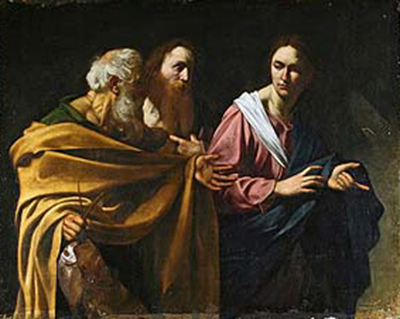The Calling of Saints Peter and Andrew is dated at around 1604 and is a Baroque painting from iconic artist Caravaggio. It can now be found in the prestigious Royal Collection and is normally on display at Hampton Court Palace in the south of England.
This tall painting measures 176cm in height, and around 140cm in width. It is a key part of an extraordinary collection of art owned by the British Royal Family, which has been slowly built up over many centuries. Efforts have been made in recent generations at allowing the public to be able to see as much of it as possible and this means much of it is spread between their various properties. There is also a gallery in central London whose sole purpose is to do the same. They themselves have dated this piece at around the 1603-1606 mark, meaning that we are still not entirely sure when Caravaggio produced it. Thankfully, this is not one of the paintings from his career with questionable attribution, and so its value to the collection is entirely assured. The part of Hampton Court which houses some of these paintings is known as the Cumberland Art Gallery and also features artworks such as Triptych: Crucifixion and other Scenes, circa 1302-8 by Duccio di Buoninsegna, Portrait of Mary, Princess Royal and later Princess of Orange by Sir Anthony van Dyck and also A Flemish Fair by Jan Brueghel the Elder.
The Gospel of Matthew features a passage from where this painting finds influence. It tells of when Christ asks Peter and Andrew to become his disciples, with all three pictured within this piece. Christ looks decidely young, calling on the help and expertise of these elderly men who stand to his right. Their expressions are series but amicable. Nearest us is Simon, who later became known as Peter, and he wears a mustard brown coat whilst holding a fish in his right hand. Both Peter and Andrew sport large, unstyled beards which cofirms their age and also suggests a wise nature. The difference in youthfulness between themselves and Christ gives a further indication of how he was requiring their help. The canvas itself is known to have become damaged around the edges, but the main figures have been preserved relatively well. As Caravaggio left most of his backgrounds very dark in colour, much of the damage cannot even be seen from afar and so the need for alterations is not as strong.
The piece actually came under the ownership of the British Royal Family as early as 1637, having been purchased by Charles I. It would then later be bought again by Charles II before being passed on to Queen Elizabeth II. The piece has been kept in Hampton Court Palace for many years and was recently studied by external experts in order to finally confirm that it was definitely from the hand of Caravaggio. This confirmation has led to a value of around £50m being placed on the item, but it is hard to imagine it coming up for sale any time soon.




